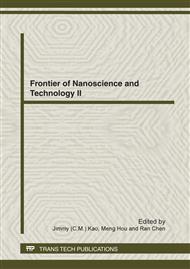p.193
p.197
p.202
p.206
p.210
p.214
p.219
p.223
p.229
The Effects of Nanocrystaline Cellulose on Polysulfone Hollow-Fiber Ultrafiltration Membrane
Abstract:
Nanocrystalline cellulose was used to blend with polysulfone to improve the hydrophicility and mechanical properties of PS hollow fiber ultrafiltration membrane. The method of dry-jet/wet-spining was adopted to form the hollow fiber by the mechanism of phase-inversion. In addition, the content of NCC was increased gradually from 0% to 1 wt% to examin the permeation flux, rejection ratio of bovine serum albumin(BSA) and mechanical strength of PS hollow-fiber. We find that the pure water flux was soared when NCC content was increased. The tensile strength and elongation at break were also detected and calculated. The results indicated that the properties of PS hollow-fiber membrane with appropriate NCC content were enhanced. The hollow fiber membranes were also observed with scaning electron microscopy(SEM) to explore the porous structure
Info:
Periodical:
Pages:
210-213
Citation:
Online since:
June 2012
Authors:
Keywords:
Price:
Сopyright:
© 2012 Trans Tech Publications Ltd. All Rights Reserved
Share:
Citation:



